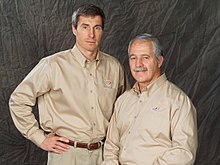
Yury Valentinovich Lonchakov is a Russian former cosmonaut and a veteran of three space missions. He has spent 200 days in space and has conducted two career spacewalks.

Yuri Pavlovich Gidzenko is a Russian cosmonaut. He was a test cosmonaut of the Yuri Gagarin Cosmonaut Training Center (TsPK). Gidzenko has flown into space three times and has lived on board the Mir and the International Space Station. He has also conducted two career spacewalks. Although he retired on July 15, 2001, he continued his employment by a special contract until Soyuz TM-34 concluded. Since 2004 to May 2009, Gidzenko was the Director of the 3rd department within the TsPK. Since May 2009 he serves as the Deputy Chief of Cosmonaut Training Center TsPK.

Scott Joseph Kelly is an American engineer, retired astronaut, and naval aviator. A veteran of four space flights, Kelly commanded the International Space Station (ISS) on Expeditions 26, 45, and 46.

Sergei Konstantinovich Krikalev is a Soviet and Russian mechanical engineer and former cosmonaut. As a prominent rocket scientist, he is a veteran of six space flights and ranks third to Gennady Padalka and Yuri Malenchenko for the amount of time in space: a total of 803 days, 9 hours, and 39 minutes.
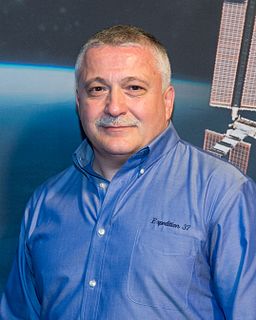
Fyodor Nikolayevich Yurchikhin is a Russian cosmonaut of Greek descent, engineer and RSC Energia test-pilot who has flown on five spaceflights. His first spaceflight was a 10-day Space Shuttle mission STS-112. His second was a long-duration stay aboard the International Space Station (ISS) as a Flight Engineer for Expedition 15; for this mission he was launched in the Soyuz TMA-10 spacecraft. He has undertaken two further long-duration stays aboard the ISS, as a crew member of Expedition 24 / 25. For this mission he was launched with the spacecraft Soyuz TMA-19, and he landed in November 2010, also with the Soyuz TMA-19 spacecraft. He served as Soyuz commander for his fourth mission aboard Soyuz TMA-09M, as flight engineer for Expedition 36 and ISS Commander for Expedition 37. In April 2017, Yurchikhin launched on Soyuz MS-04 for the fifth spaceflight of his career, a six-month mission to the ISS as part of Expedition 51 and 52, for which he was the commander.

Expedition 9 (2004) was the ninth expedition to the International Space Station.

Expedition 8 was the eighth expedition to the International Space Station.
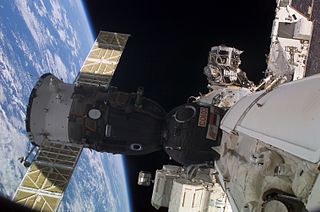
Expedition 7 was the seventh expedition to the International Space Station.

Soichi Noguchi is a Japanese aeronautical engineer and JAXA astronaut. His first spaceflight was as a Mission Specialist aboard STS-114 on 26 July 2005 for NASA's first "return to flight" Space Shuttle mission after the Columbia disaster. He was also in space as part of the Soyuz TMA-17 crew and Expedition 22 to the International Space Station (ISS), returning to Earth on 2 June 2010. He is the sixth Japanese astronaut to fly in space, the fifth to fly on the Space Shuttle, and the first to fly on Crew Dragon.

Expedition 14 was the 14th expedition to the International Space Station (ISS). Commander Michael López-Alegría, and flight engineer Mikhail Tyurin launched from Baikonur Cosmodrome on 18 September 2006, 04:09 UTC, aboard Soyuz TMA-9. They joined Thomas Reiter, who had arrived at the ISS on 6 July 2006 aboard Space Shuttle Discovery during mission STS-121. In December 2006, Discovery mission STS-116 brought Sunita Williams to replace Reiter as the third member of Expedition 14. On 21 April 2007, López-Alegría and Tyurin returned to Earth aboard TMA-9. Landing occurred at 12:31:30 UTC.

Expedition 15 was the 15th expedition to the International Space Station (ISS). Four crew members participated in the expedition, although for most of the expedition's duration only three were on the station at any one time. During Expedition 15, the ISS Integrated Truss Structure was expanded twice: STS-117 brought the S3/S4 truss, and STS-118 brought the S5 truss.

Akihiko Hoshide is a Japanese engineer, JAXA astronaut, and former Commander of the International Space Station. On August 30, 2012, Hoshide became the third Japanese astronaut to walk in space.
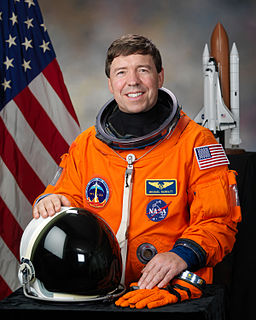
Michael Reed Barratt is an American physician and a NASA astronaut. Specializing in aerospace medicine, he served as a flight surgeon for NASA before his selection as an astronaut, and has played a role in developing NASA's space medicine programs for both the Shuttle-Mir Program and International Space Station. His first spaceflight was a long-duration mission to the International Space Station, as a Flight Engineer in the Expedition 19 and 20 crew. In March 2011, Barratt completed his second spaceflight as a crew member of STS-133.

Expedition 16 was the 16th expedition to the International Space Station (ISS). The first two crew members, Yuri Malenchenko and Peggy Whitson, launched on 10 October 2007, aboard Soyuz TMA-11, and were joined by spaceflight participant Sheikh Muszaphar Shukor, the first Malaysian in space.

NASA Astronaut Group 16 was a group of 44 astronauts announced by NASA on May 1, 1996. The class was nicknamed "The Sardines" for being such a large class, humorously implying that their training sessions would be as tightly packed as sardines in a can. These 44 candidates compose the largest astronaut class to date. NASA selected so many candidates in preparation for the anticipated need for ISS crew members, along with regular shuttle needs. Nine of the 44 astronauts selected were from other countries including 5 from Europe and 2 from Canada and Japan.

Expedition 26 was the 26th long-duration mission to the International Space Station. The expedition's first three crew members – one US astronaut and two Russian cosmonauts – arrived at the station on board Soyuz TMA-01M on 10 October 2010. Expedition 26 officially began the following month on 26 November, when half of the crew of the previous mission, Expedition 25, returned to Earth on board Soyuz TMA-19. The rest of the Expedition 26 crew – one US astronaut, one Russian cosmonaut and one ESA astronaut – joined the trio already on board when their spacecraft, Soyuz TMA-20, docked with the station on 17 December 2010.
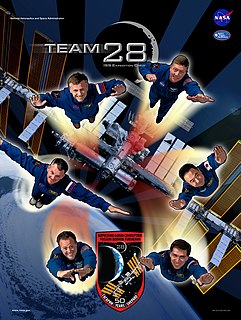
Expedition 28 was the 28th long-duration expedition to the International Space Station, and began on 23 May 2011 with the departure of the members of Expedition 27. The first three members of Expedition 28 arrived on the ISS aboard the Soyuz TMA-21 spacecraft on 4 April 2011, and were joined on 9 June 2011 by the three other crew members, who arrived aboard Soyuz TMA-02M. The expedition saw a number of significant events, including the final Space Shuttle mission, STS-135, which took place in July 2011. Expedition 28 was superseded by Expedition 29 on 16 September 2011.

Kjell Norwood Lindgren is an American astronaut who was selected in 2009. Lindgren was selected in June 2009 as a member of the NASA Astronaut Group 20. He launched to the International Space Station (ISS) as part of Expedition 44/45 on July 22, 2015.


